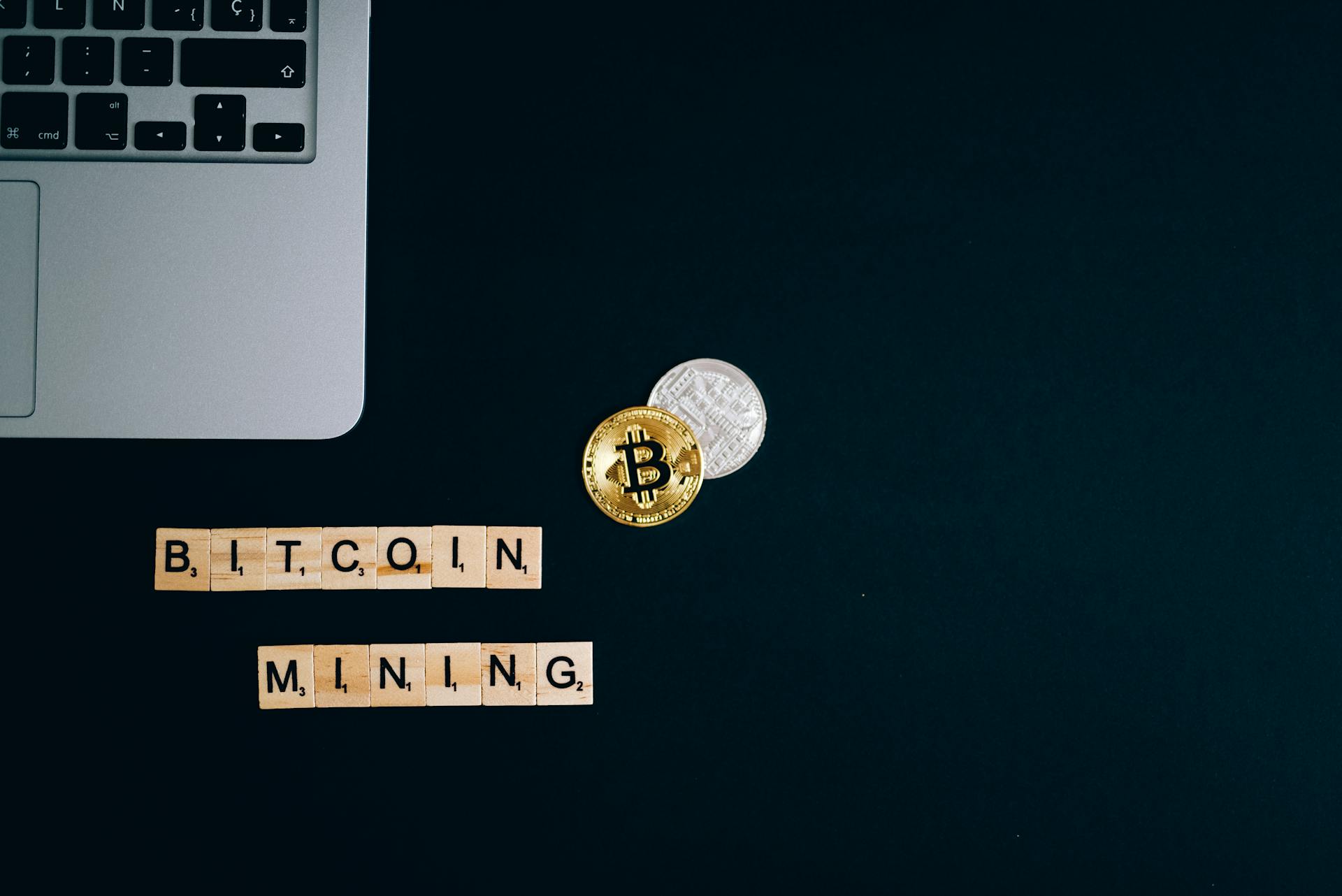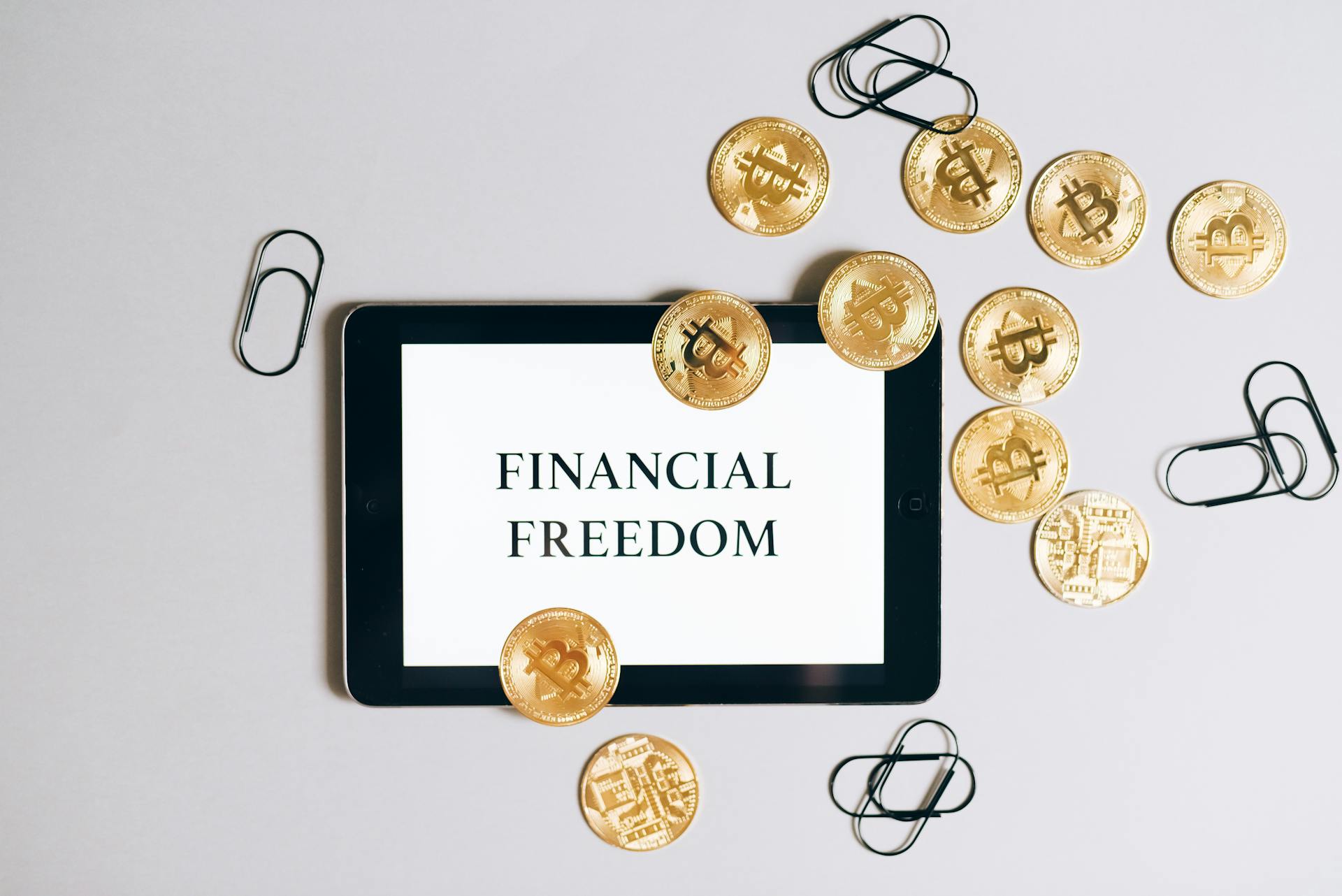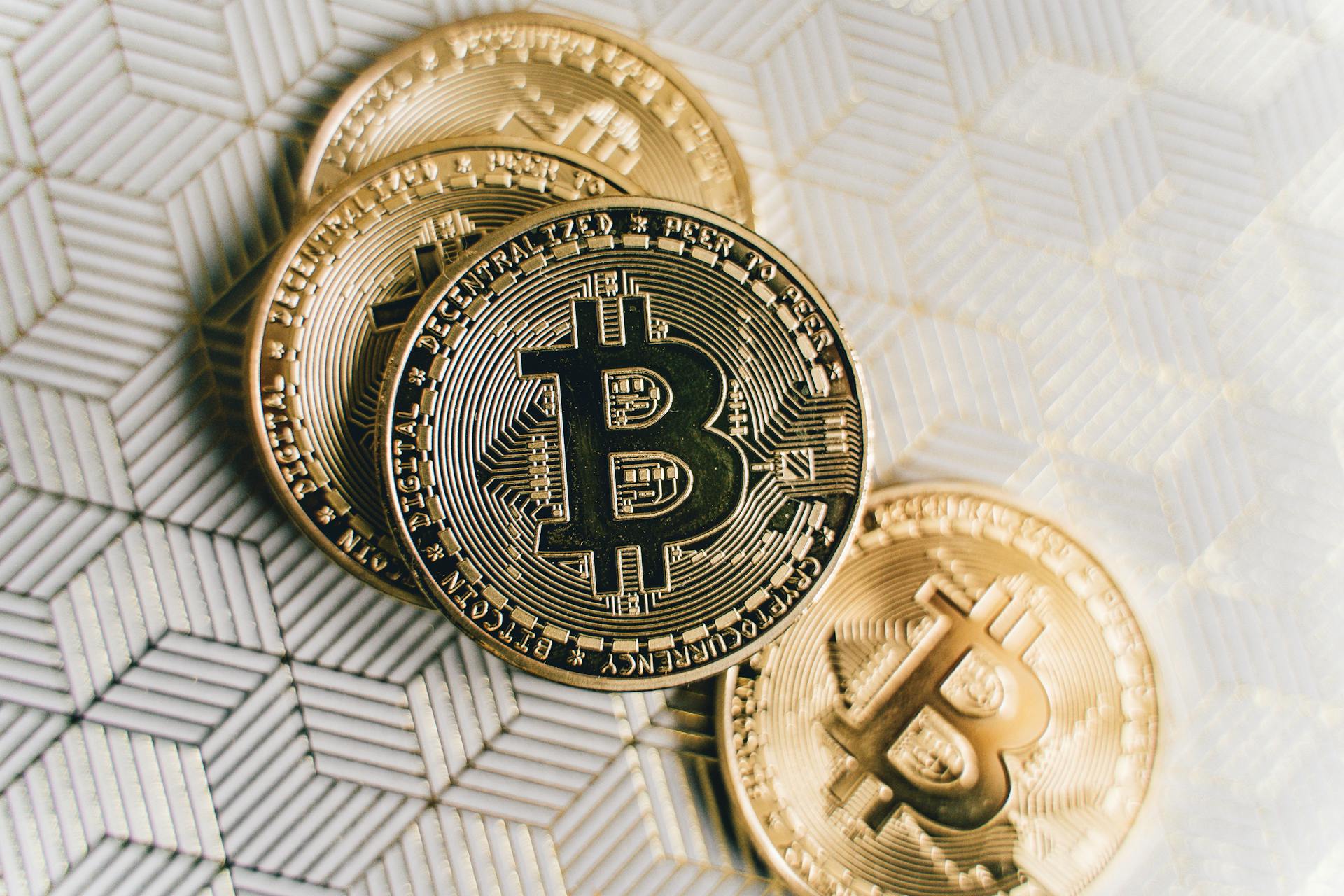
The story of how bitcoins came to be is a fascinating one. Satoshi Nakamoto, a pseudonymous individual or group, is credited with creating the first bitcoin in 2009.
Bitcoin was the first decentralized digital currency, designed to allow for peer-to-peer transactions without the need for intermediaries like banks.
Satoshi Nakamoto's true identity remains a mystery to this day, but their whitepaper, published in October 2008, outlined the concept of a decentralized digital currency.
The whitepaper proposed a new form of electronic cash that used cryptography to secure transactions and control the creation of new units.
For another approach, see: P2p Bitcoins
How Bitcoin Transactions Work
Bitcoin transactions work by being broadcast to the network and placed in a pool of unconfirmed transactions.
Miners select transactions from this pool to include in the next block.
Each transaction is verified using cryptographic signatures to ensure the sender has the necessary funds and authorization.
The verification process is crucial, as it ensures that transactions are legitimate and can't be tampered with.
Once verified, the transaction is added to a block, which is then mined and added to the blockchain, making it permanent and irreversible.
The blockchain serves as a public ledger, recording all Bitcoin transactions.
This transparency allows anyone to view transaction history, though user identities remain pseudonymous.
Consider reading: Block Reward
The Bitcoin Network
The Bitcoin Network is a decentralized system that relies on specialized hardware to solve complex mathematical problems. These problems validate transactions and add new blocks to the blockchain.
Miners use this hardware to compete and solve these problems first, with the winner receiving newly minted bitcoins as a reward. This process, known as proof-of-work, ensures the network's security by making it computationally expensive to attack or manipulate.
The mining reward halves approximately every four years, controlling inflation and maintaining Bitcoin's scarcity. This helps regulate the rate at which new bitcoins enter circulation.
Miners play a crucial role in maintaining the network's integrity and security, making them a vital part of the Bitcoin ecosystem.
Additional reading: Bitcoin Atm Milwaukee - Coinhub
Basics of Mining
Bitcoin mining is the backbone of the cryptocurrency's network, ensuring its security and functionality. It's a crucial process that validates transactions and adds new blocks to the blockchain.
Miners compete to solve complex mathematical problems, with the winner receiving newly minted bitcoins as a reward. This process is known as proof-of-work.
You might enjoy: Bitcoin Atm Tampa - Coinhub
The difficulty of these problems adjusts automatically to maintain a consistent block time of about 10 minutes, regardless of the total network mining power. This ensures the network's security by making it extremely costly and time-consuming for attackers to alter the blockchain.
Miners also help regulate the rate at which new bitcoins enter circulation. The mining reward halves approximately every four years, controlling inflation and maintaining Bitcoin's scarcity.
To become a miner, you'll need significant investment in specialized hardware and energy consumption. But the rewards are worth it, as miners earn the right to add the next block and receive newly minted bitcoins.
The proof-of-work consensus mechanism used by the Bitcoin network requires miners to solve complex mathematical problems that demand substantial computational power. This prevents double-spending by requiring majority consensus for transaction validation.
Miners play a vital role in maintaining the network's integrity and security, and their efforts are essential for the continued growth and success of the Bitcoin network.
A fresh viewpoint: How Long Do Robinhood Crypto Transfers Take
Mining Rewards
Bitcoin miners are incentivized to secure the network through a combination of block rewards and transaction fees. Block rewards are newly created bitcoins awarded to the miner who successfully adds a new block to the blockchain, currently standing at 3.125 bitcoins per block.
Miners compete to solve complex mathematical problems, with the winner receiving the block reward. This process, known as proof-of-work, ensures the network's security by making it computationally expensive to attack or manipulate.
Transaction fees, paid by users to prioritize their transactions, provide an additional income stream for miners. As the block reward diminishes over time due to Bitcoin's halving events, transaction fees are expected to become the primary incentive for miners.
The mining reward halves approximately every four years, controlling inflation and maintaining Bitcoin's scarcity. This process regulates the rate at which new bitcoins enter circulation.
Consider reading: Crypto Coin Rewards
Mining Methods
Bitcoin mining is the backbone of the cryptocurrency's network, ensuring its security and functionality. Miners compete to solve complex mathematical problems, validating transactions and adding new blocks to the blockchain.
The proof-of-work process makes it computationally expensive to attack or manipulate the network, maintaining its integrity and security. Miners receive newly minted bitcoins as a reward for solving these problems first.
Miners play a crucial role in regulating the rate at which new bitcoins enter circulation, controlling inflation and maintaining Bitcoin's scarcity. The mining reward halves approximately every four years.
Pool mining combines the computational power of multiple miners, increasing the chances of solving blocks. Participants contribute their mining power to a pool and share the rewards proportionally based on their contributed work.
Pool mining offers more frequent, albeit smaller, payouts compared to solo mining. Pools typically charge a small fee for their services.
You might like: Mining Hub Pool
The Genesis Block
The Genesis Block was mined on January 3, 2009, 15 years ago, and it's still in the Bitcoin network today.
This block is also known as Block 0 or Block 1, and it serves as the basis of the entire Bitcoin trading system.
Discover more: Bitcoin Block Reward
The Genesis Block contains a "secret" message written by Satoshi, which refers to a headline in The London Times about the failure of the British government to stimulate the economy after the financial crisis of 2007-2008.
Many people believe that this message serves as a mission statement for the Bitcoin Blockchain, aiming to prevent people from having to hand over money to a bank as an alternative to stashing cash under the mattress.
The Genesis Block is a significant part of Bitcoin's history, and it's a testament to Satoshi's vision for a decentralized and transparent financial system.
Readers also liked: Bitcoin Satoshi Faucet
Satoshi Mines First Blockchain Block
Satoshi mined the first block of the Bitcoin blockchain 15 years ago.
The Genesis Block, also known as Block 0 or Block 1, was mined on January 3, 2009, a significant event in Bitcoin's history.
The Genesis Block is still in the Bitcoin network and will remain there as long as there is a computer running the Bitcoin software.
All nodes in the Bitcoin network can consult the Genesis Block, even if it's at the other end of the network with hundreds of thousands of blocks.
Check this out: What Happens When All Bitcoins Are Mined
What Is a Block?
A block is a collection of transactions that are validated together. The transactions in a block are added all at once to the network.
The number of transactions in a Bitcoin block varies, but is currently usually between 1,000 and 2,500. This can impact the mining process, making it more or less difficult.
Blocks take around 10 minutes to be validated or “mined”. This timing is pre-set in the software to keep the network secure and ensure a competitive mining process.
Miners are rewarded for each block mined, and the value of the reward received has fallen to 6.25 BTC.
You might enjoy: Bitcoins Transactions per Second
The Genesis Block Secret
The Genesis Block contains a special message that has sparked a lot of debate among Bitcoin enthusiasts.
Satoshi wrote a "secret" message inside the standard lines of data attached to the block, which refers to a headline in The London Times about the failure of the British government to stimulate the economy after the financial crisis of 2007–2008.
The message is a quote from the January 3, 2009 edition of The London Times, and it's been interpreted in many different ways.
Most people believe that the message serves as a mission statement for the Bitcoin Blockchain itself, aiming to prevent people from having to hand over money to a bank as an alternative to stashing cash under the mattress.
Satoshi's goal may have been to create a system where people can trust each other directly, without the need for banks or governments.
Some people think that Satoshi chose this particular message to appear on the Genesis Block because it reflects his desire to start a new era where people have control over their own money.
The message has also been seen as a response to the financial crisis of 2007–2008, where banks were bailed out by governments using taxpayers' money.
However, another theory suggests that Satoshi included the headline to prove that the code was not written before January 3, 2009, and to dispel any mention that he had mined the block in advance to gain some advantage as its creator.
The Genesis Block's secret message has become a topic of debate among Bitcoin enthusiasts, with many different interpretations and theories.
You might like: Machine Money
Second Block Mined on January 9th
The second Bitcoin block was mined on January 9th, six days after the first.
This was outside the time allotted by the Bitcoin software, which expected blocks to be mined every 10 minutes.
One of the theories is that the algorithm that adjusts the mining difficulty to maintain the 10 minutes only kicks in every two weeks or so.
This delay in the second block's mining had a significant impact on the early Bitcoin network.
Frequently Asked Questions
Where do bitcoins come from when you mine them?
Bitcoins are created when miners process transactions on the decentralized network, earning new bitcoins as a payment for their work. This process is called mining, where transactions are verified and added to the public ledger.
Where does the money behind Bitcoin come from?
Bitcoin's value is based on trust in its security, scarcity, and predictability, not on a physical commodity or government backing. This unique foundation is what gives Bitcoin its value and sets it apart from traditional currencies.
Sources
- https://www.forbes.com/sites/digital-assets/article/how-to-mine-bitcoin/
- https://tatianarevoredo.medium.com/bitcoin-genesis-day-63df91ec3ef3
- https://www.jmco.com/articles/tax/brief-history-bitcoin/
- https://qz.com/bitcoin-history-creation-origin-price-1851347621
- https://www.knoxnews.com/story/special/contributor-content/2024/02/14/bitcoin-mining-explained-how-btc-is-created/72600527007/
Featured Images: pexels.com


